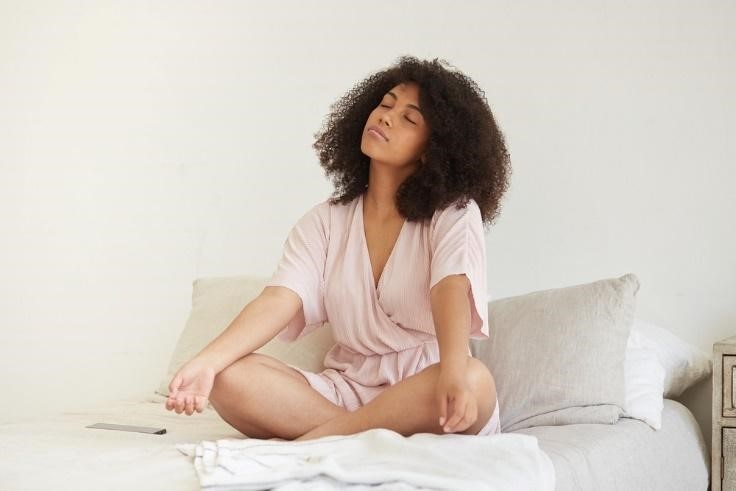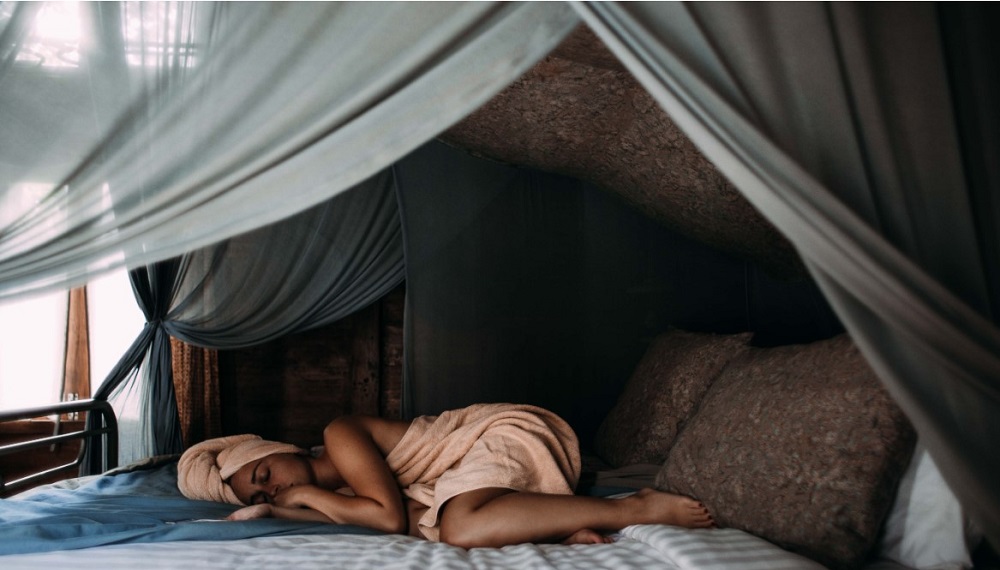Stress and anxiety are steadily on the rise nowadays, which is not surprising considering many people wear busyness as a badge of honor to feel important or to sidestep being alone with their thoughts.
Unfortunately, living with stress and anxiety can affect your sleep quality, opening the door to other physical and mental health problems. If you struggle with insomnia or simply want to enjoy better sleep, you might want to try the military breathing technique for sleep and relaxation.
In this quick post, we’ll explain the military breathing technique and how to do it and share three effective tips to get the most out of the breathwork.
What Is the Military Breathing Technique?
Military breathing goes by a few different names, including tactical breathing, four-square breathing, controlled breathing, and box breathing.
It is a breathing method used by Special Forces and other military personnel in high-stress situations to reduce stress. A recent study reveals the effectiveness of this tactical breathing technique for quickly lowering stress and helping military and law enforcement personnel maintain alertness during high-risk missions.
Essentially, the breathing method divides the breathing cycle into four parts, each having the same duration. The practice involves:
- Breathing in deeply through the nose while counting from one to four
- Holding the breath for the same count
- Letting it go while counting to four
- Pausing for another count of four
You don’t have to be a soldier or work in law enforcement to use this breathing method. You can use this breathing exercise if you have a stressful job, struggle to have a restful sleep, or have trouble falling asleep.
In addition to increasing your chances of sleeping better (even when you have insomnia), military breathing offers other benefits, such as:
- Managing stress when faced with overwhelming situations
- Controlling hyperventilation
- Relieving worry and panic
- Improving your overall mood by decreasing cortisol and lowering blood pressure
How to Do the Military Breathing Technique

The military or tactical breathing method involves breathing in a four-phase cycle of equal length. Here’s how to do it:
- Lie on your back (if you’re already in bed) or sit upright with your back supported in a comfortable chair.
- Close your eyes and bring your attention to your breath.
- Take a slow, deep breath through your nose while slowly counting to four in your head as you feel the cool air enter your lungs.
- Hold your breath and slowly count to four again.
- Exhale through your mouth for another count of four, noting the warm air leaving your lungs.
- Lastly, hold your breath for a count of four before repeating the process.
When it comes down to it, box breathing (or, more technically, military breathing) is like meditation, even though you’re mostly focused on breath control. This means you’ll get the best results when practicing the technique in a relatively quiet, stress-free environment that supports deep relaxation and sleep.
We’ll cover how to create a sleep-friendly environment in a bit. For now, let’s see how breathing affects sleep quality.
How Your Breathing Pattern Affects Your Sleep Quality
Deliberate breathing exercises, like military breathing, calm the autonomic nervous system. By breathing deeply into the abdomen, you engage the parasympathetic nervous system, which slows down your heart rate, makes you breathe slower, and relaxes your body.
On the other hand, shallow breathing can trigger the sympathetic nervous system, which is the fight or flight response.
If you hyperventilate or breathe too quickly when trying to fall asleep, it revs up your sympathetic nervous system and activates the processes that can help you respond to threatening or stressful situations.
This prevents you from falling asleep and gets worse as you become frustrated and anxious because you can’t fall asleep.
Incorporating breathwork exercises for relaxation and sleep can help you break this vicious cycle.
Does the Military Breathing Technique Work?
Many people report that the military breathing technique helps calm their bodies and minds, leading to increased relaxation and better sleep.
These positive effects are to be expected, considering the breathing technique helps to direct attention to regulating the pace of breathing. Breathing this way decreases the body’s physiological responses, meaning:
- The heart rate slows down
- There is a decrease in muscle tension
- The blood pressure goes down
- Breathing becomes slower and deeper
These signs associated with practicing military breathing can help improve sleep quality in many people.
Here’s the thing, though.
Not all sleep interventions or strategies work for everyone, regardless of how effective they may be.
Some people find aromatherapy more effective for falling and staying asleep longer, while others get better results from listening to night sounds or soothing music. Still others may prefer using one or more Zen breathing techniques to reduce stress, promote relaxation, and improve sleep quality.
Here’s the bottom line: there is no one-size-fits-all when it comes to sleep interventions. Beyond stress and anxiety, several other factors can affect your sleep quality, even if you use breathwork exercises for sleep.
For example, your lifestyle and sleep hygiene greatly impact your overall sleep quality. Also, certain medical conditions and medications can affect how quickly you fall asleep and how long you stay asleep.
If you’ve tried the military breathing technique or other sleep-promoting interventions but still don’t notice any improvement in your sleep quality, we strongly recommend identifying and addressing any underlying issues that may be contributing to poor sleep.
Three Effective Lifestyle Tips for Better Sleep

Indeed, the military breathing technique for sleep is effective and works well for reducing stress and increasing relaxation. However, it is not a silver bullet for all sleep problems.
Poor sleep hygiene makes you less likely to enjoy quality sleep, regardless of the breathing cycle you use before or during bedtime.
Consider the following lifestyle tips to increase the effectiveness of breathwork on your sleep pattern.
1. Make Your Bedroom a Sleep Sanctuary
Ideally, your bedroom should be a calming place that promotes rest and relaxation. You want to make sure the atmosphere is conducive for sleeping, with as little noise and light as possible.
Besides investing in a comfortable mattress and pillows, you want to find the temperature that works best for you and supports deep sleep, depending on the weather.
Remember to remove TV, computers, or anything that can cause distractions from your sleeping space. Use calming scents to help you fall asleep faster and improve your sleep quality, especially if you struggle with anxiety or chronic stress.
And by all means, keep your bedroom free of clutter, as it can be difficult to enjoy a good sleep in a disorganized, messy space.
2. Follow a Relaxing Bedtime Routine
Create a winding down routine and aim to follow it every night before you sleep. Remember, we are creatures of habit, and once we form one, it tends to run on autopilot.
Try as much as possible to stick to a sequence of relaxing activities before time. For example, you can start winding down by taking a cold or warm shower, listening to some sleeping music, and finally practicing the military breathing technique for sleep as you drift off.
Whatever relaxing bedtime activities and sequence you choose, keep them up for a while, and soon enough, your body will automatically get ready for sleep once you start the winding down routine.
3. Avoid Caffeine Several Hours Before Bedtime
Caffeine stimulates the central nervous system, meaning it typically increases alertness and reduces fatigue. While this effect is generally good if you’re looking to stay sharp, it’s the last thing you want when trying to catch some quality shuteye.
Consuming caffeine close to your bedtime essentially prevents you from falling asleep, as the substance blocks adenosine, the neurotransmitter in charge of promoting sleep, suppressing its sleep-inducing effect.
That said, you don’t have to completely cut out caffeine. The trick is to be mindful of when you consume it. An empirical study published in the Journal of Clinical Sleep Medicine recommends avoiding caffeine intake at least 6 hours before bedtime.
For example, if you usually hit the sack at 11 pm, you should aim to stop drinking caffeine by 5 pm to increase your chances of getting better sleep. You might need to stop consuming caffeine much earlier in the day if you’re particularly sensitive to it.
Keep in mind that coffee is not the only beverage containing caffeine. The substance is also found in chocolate, energy drinks, tea, and soda.
The Secret to Better Sleep
Deliberate breathing is one of the lesser-known secrets to better sleep. This is probably because breathing is something we do even without realizing it, so it’s easy to take it for granted.
Indeed, the military breathing technique for sleep is not the be-all-and-end-all of every sleep-related problem; however, it is a simple yet powerful way to calm your body and mind and gently prepare you for sleep.
Want to learn more ways to improve your sleep quality? Read our detailed guide on how to sleep better.


